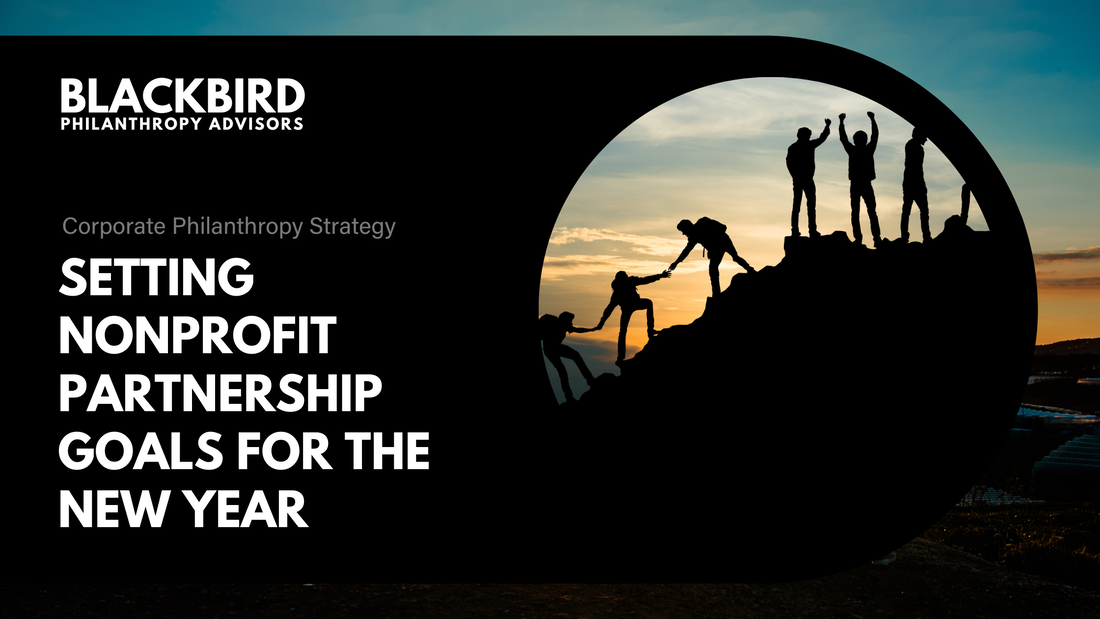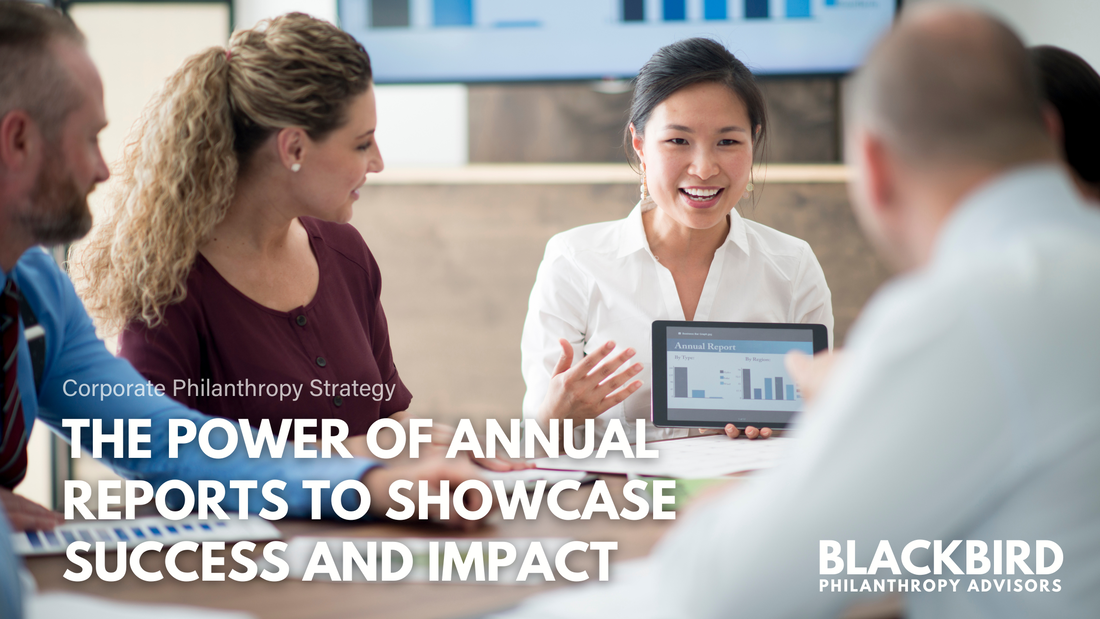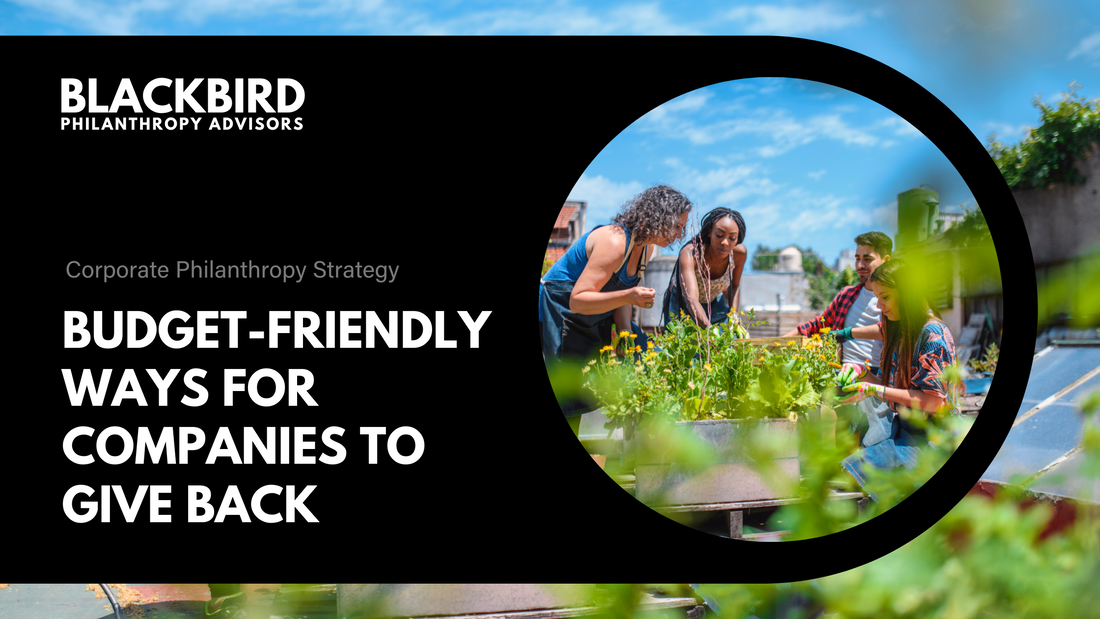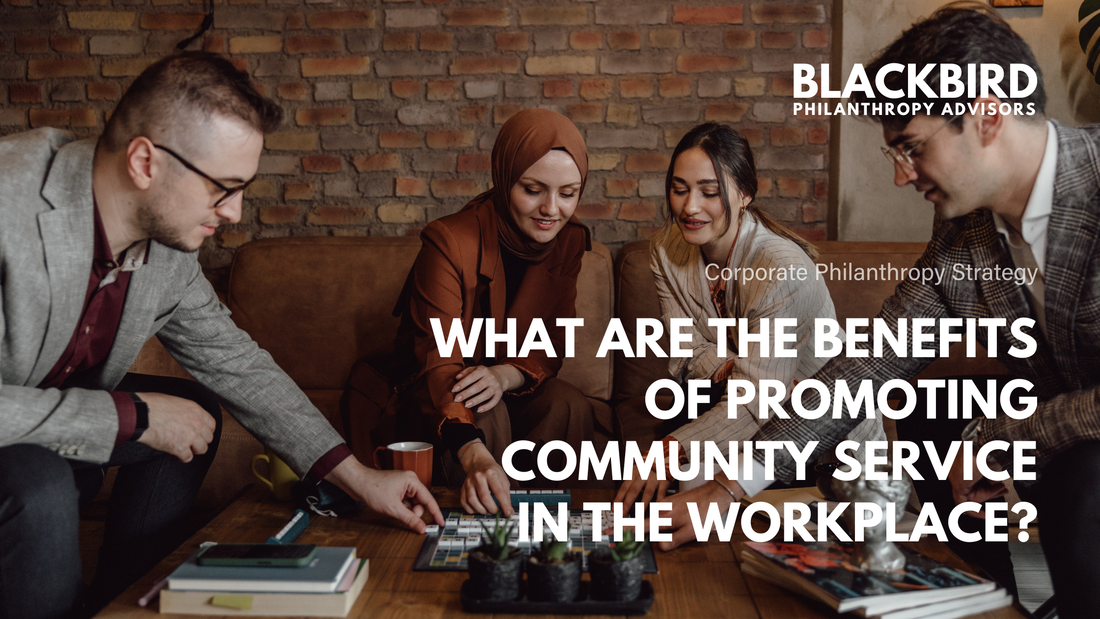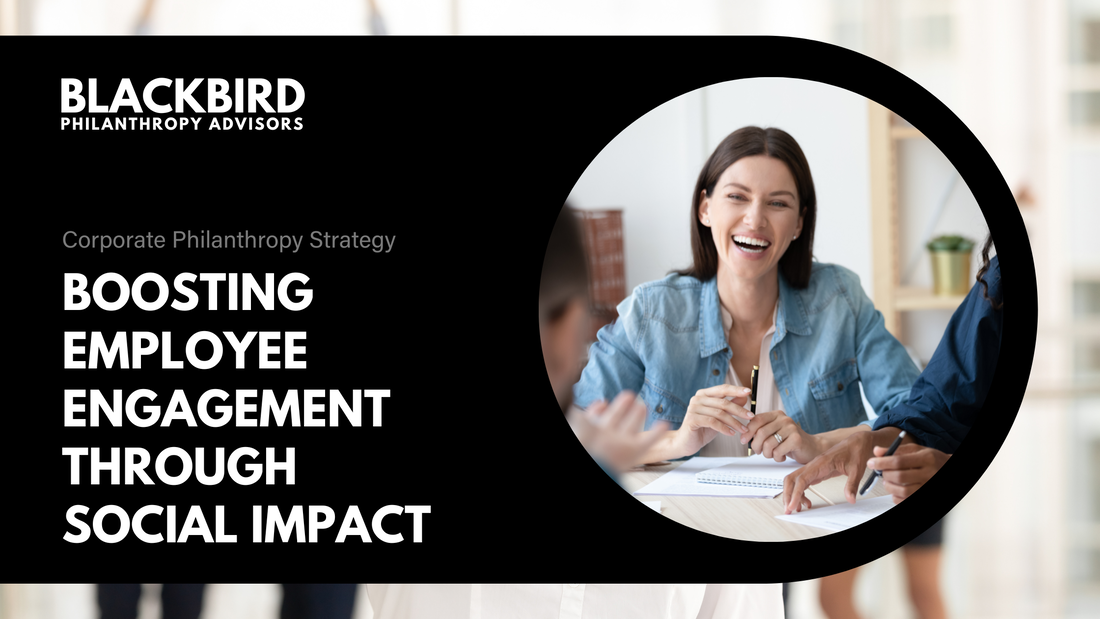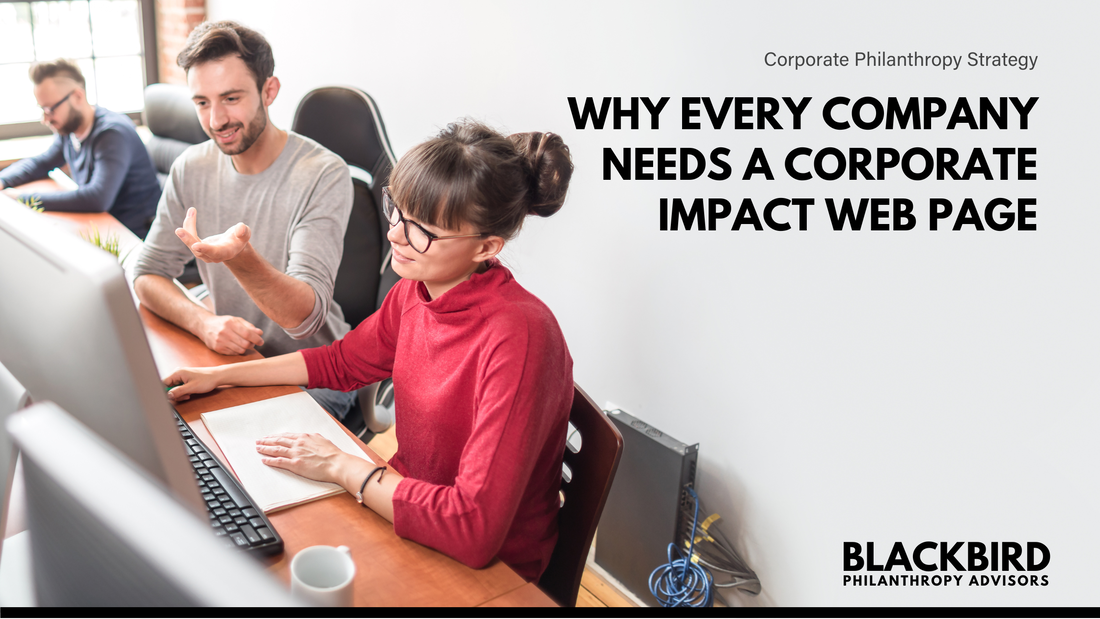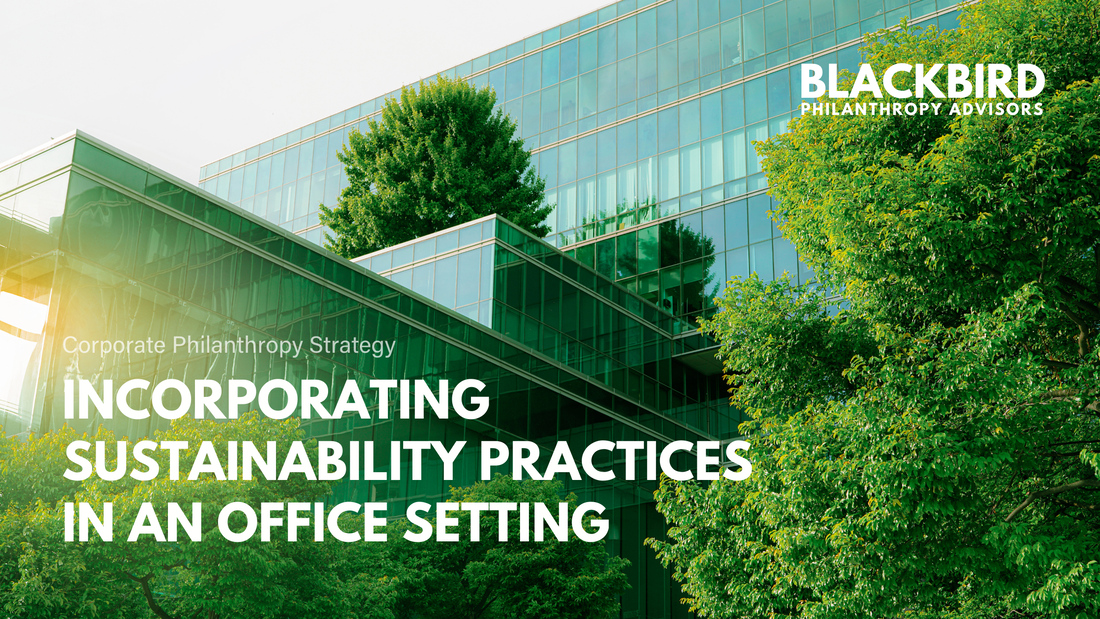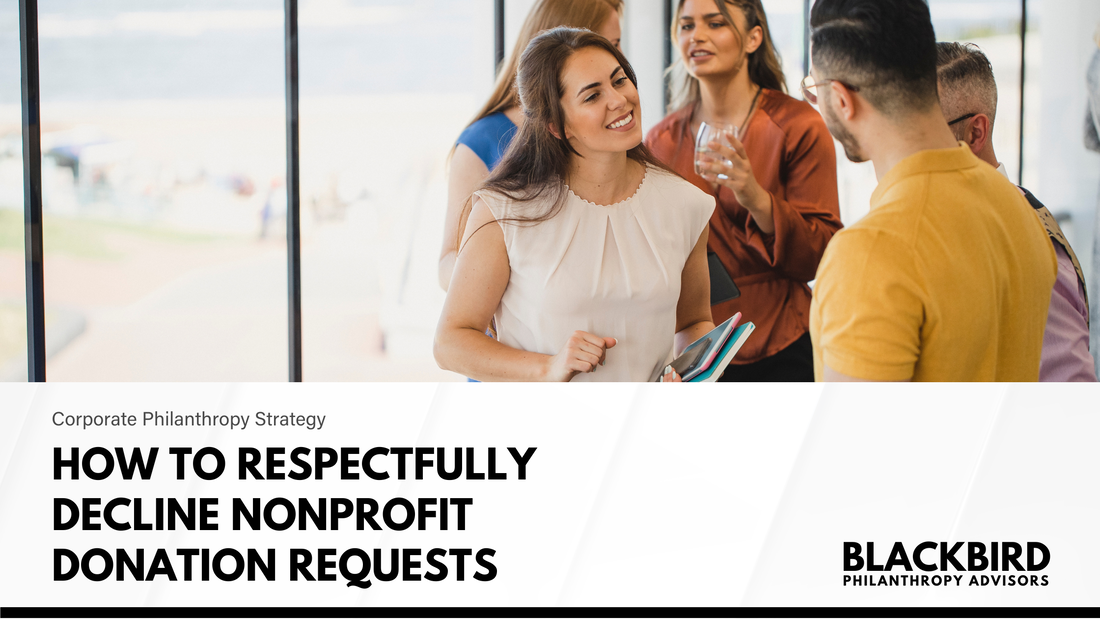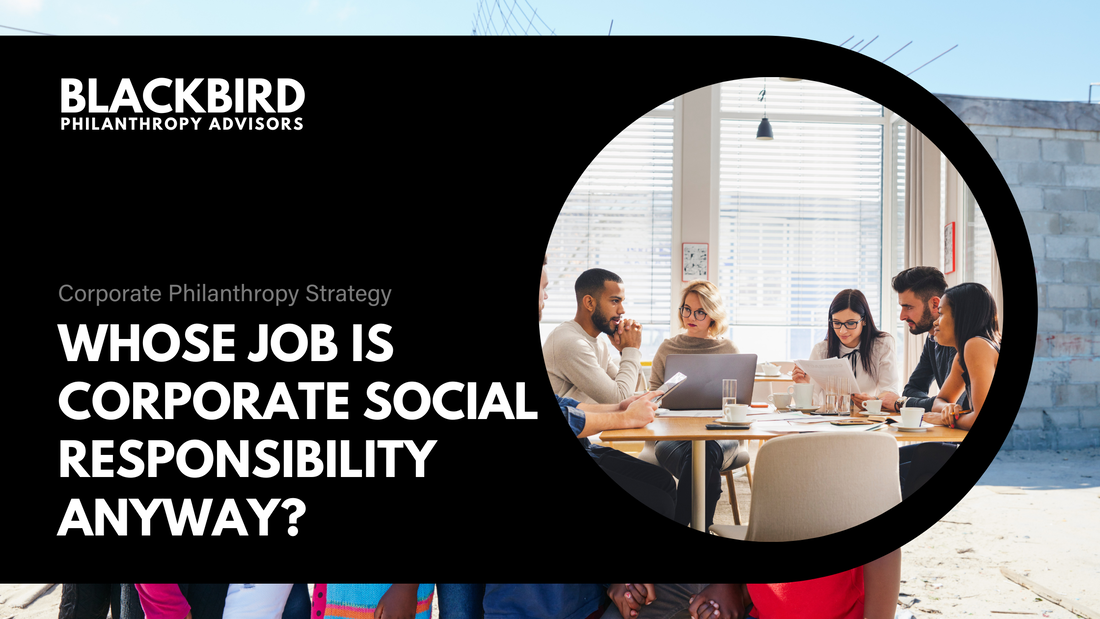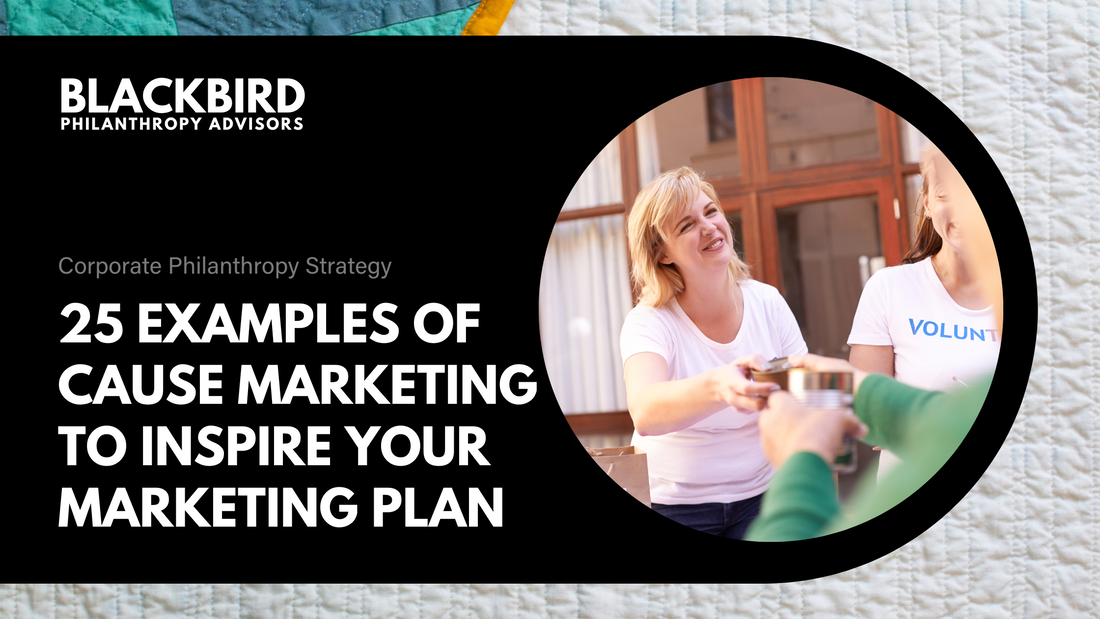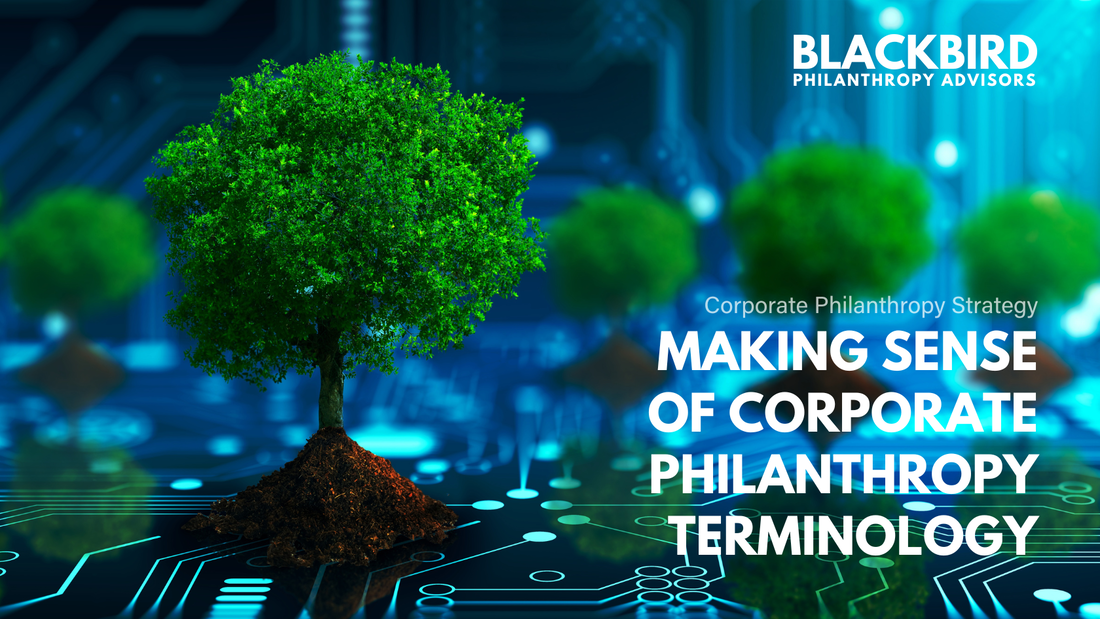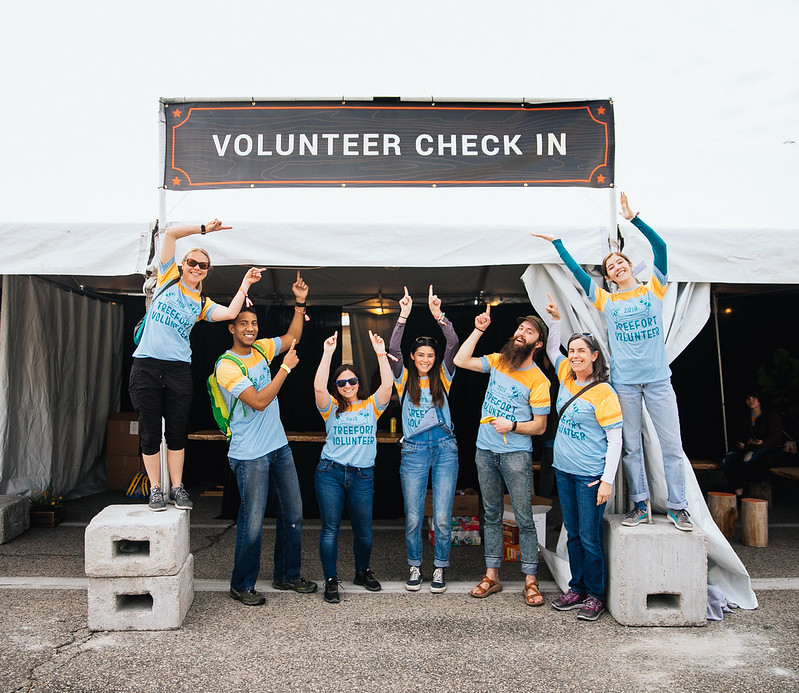Social Impact InsightsOur blog provides insights for social impact professionals in business and nonprofits. We offer advice on making the greatest impact in your organization by giving clear real-world advice on important topics of today.
|
|
As the year draws to a close, it's a pivotal time for corporate donors to reflect on their philanthropic journeys. At Blackbird Philanthropy Advisors, we emphasize the importance of this period not just for reviewing past contributions but for strategizing future engagements. A key aspect of this process involves assessing relationships with nonprofit partners and planning giving priorities and employee engagement activities for the upcoming year. Our blog post below provides examples to demonstrate how corporations can apply these key points in real-life scenarios, creating a meaningful and strategic approach to corporate philanthropy. Evaluating Nonprofit Partnerships
Planning Giving Priorities
Enhancing Employee Engagement
Looking Ahead
The end of the year is more than just a time for reflection; it's an opportunity to strategize and set intentions for meaningful philanthropy. At Blackbird Philanthropy Advisors, we believe in the power of thoughtful planning and the impact it can have on both corporations and communities. As you assess your nonprofit relationships and plan for the upcoming year, remember that your corporate philanthropy is not just about giving back — it's about moving forward together.
0 Comments
Annual reports often fly under the radar, overshadowed by the glitz and glamour of flashy marketing campaigns and product launches. However, these documents play a crucial role in providing transparency, accountability, and recognition to both businesses and nonprofit organizations. In this blog, we will delve into the world of annual reports, exploring their effectiveness in two distinct realms: the corporate sector and the nonprofit world. We will also highlight the key components of a well-structured annual report and offer advice on when and where to publish it, ultimately demonstrating why annual reports are indispensable. Annual Reports for Businesses: Celebrating Achievements and Nurturing Relationships
Nonprofit Annual Reports: Recognizing Donors and Impacting Lives
Key Components of an Effective Annual Report Regardless of whether it's a business or nonprofit annual report, the following components should be included:
When and Where to Publish an Annual Report Timing is crucial when it comes to publishing annual reports:
As for the distribution channels:
The Invaluable Role of Annual Reports Annual reports are not mere paperwork but powerful tools for businesses and nonprofit organizations. They offer a comprehensive overview of an entity's performance, achievements, and impact. Beyond numbers, annual reports help nurture relationships, build trust, and inspire confidence among stakeholders. When crafted thoughtfully and distributed strategically, they become invaluable assets in achieving an organization's goals and demonstrating its commitment to transparency and success. So, whether you're a business aiming to strengthen employee relations or a nonprofit seeking to recognize donors, invest in creating an impactful annual report—it's a decision that will undoubtedly pay dividends in the long run. Contact Blackbird Philanthropy Advisors to manage your Annual Report project today. Our services include full project management, copywriting, interviews, editing, design, and distribution. In today's socially conscious world, businesses, regardless of their size, are increasingly expected to give back to their communities. While larger corporations may have substantial resources to dedicate to philanthropic endeavors, small companies can also make a significant impact without straining their finances. 1. Skill-Based Volunteering One of the most budget-friendly ways for small companies to give back is by offering their employees' skills and expertise to local nonprofits. Whether it's graphic design, marketing, web development, or legal advice, these skills can be invaluable to organizations that might not have the resources to hire professionals. Small companies can organize skill-based volunteering programs where employees dedicate a certain number of hours each month to help nonprofits in their areas of expertise. This not only benefits the community but also boosts employee morale and skill development. 2. Donation Matching Small businesses can encourage their employees to contribute to charitable causes by implementing donation matching programs. In this setup, the company matches employee donations to selected charities or causes, effectively doubling the impact of their employees' generosity. This encourages a culture of giving within the company and demonstrates a commitment to social responsibility. 3. Host Community Events Hosting community events is an excellent way for small companies to engage with their local communities. These events need not be extravagant or expensive. Simple initiatives like organizing charity walks, clean-up days, or educational workshops can bring people together and create a sense of unity and goodwill. Small businesses can also collaborate with other local businesses to share the costs of such events, making them even more cost-effective. 4. In-Kind Donations Instead of cash donations, small companies can consider making in-kind donations. This involves donating goods or services that the business already produces or offers. For example, a local bakery can donate surplus baked goods to a homeless shelter, or a marketing agency can provide pro-bono services to a nonprofit organization. In-kind donations not only reduce costs but also allow small companies to leverage their unique strengths and resources for the benefit of the community. 5. Employee Volunteer Days Allowing employees to take paid time off for volunteer work is a win-win for both the company and the community. Small businesses can offer a certain number of paid volunteer days each year, encouraging their staff to actively participate in community service. This not only promotes a culture of giving but also provides employees with a meaningful way to contribute to their communities without financial burdens. 6. Cause-Related Marketing Small companies can engage in cause-related marketing campaigns that tie their products or services to a charitable cause. For example, they can pledge to donate a percentage of their sales for a specific period to a local charity. This not only raises funds for the cause but also enhances the company's reputation and customer loyalty. 7. Mentoring and Internship Programs Small businesses can support the development of their communities by offering mentoring and internship programs to local students and aspiring professionals. This provides valuable learning opportunities for young individuals while fostering a sense of community engagement. Small companies don't need massive budgets to give back to their communities effectively. By getting creative and considering the resources they already have, they can make a meaningful impact while aligning their business goals with social responsibility. Whether through skill-based volunteering, donation matching, community events, in-kind donations, employee volunteer days, cause-related marketing, or mentoring programs, small businesses can contribute to their communities without straining their finances, ultimately creating a positive ripple effect that benefits everyone involved. Giving back is not just for the big players; it's an opportunity for every business, no matter how small, to make a difference. In today's rapidly changing business environment, success encompasses more than financial gains and market leadership. An increasing number of companies are recognizing the transformative influence of giving back to the communities they serve. Engaging in volunteerism and community service not only nurtures positive societal change but also offers a multitude of advantages for businesses themselves. From elevated employee morale to a bolstered brand reputation, corporate social responsibility has become a fundamental aspect of modern business practices. Let's delve into the reasons and methods behind promoting volunteerism and community service, creating a substantial impact within the corporate workplace. The Significance of Volunteerism: Why It Matters
Strategies to Promote Volunteerism in the Corporate Workplace
Promoting volunteerism and community service within the corporate workplace is an endeavor that yields positive outcomes for all parties involved. It enhances employee engagement, fortifies company culture, and uplifts communities, all while enhancing the brand's reputation. By embracing the ethos of giving back, companies contribute to positive change and embody the values of compassion, empathy, and responsibility. As we navigate the ever-evolving business landscape, let's remember that success is not solely measured in profits, but in the constructive impact we leave on the world around us. In today's fast-paced business world, there's a notable shift in what employees seek from their jobs. Gone are the days when a paycheck and a corner office were the only aspirations. Today's workforce, particularly the younger generation, is more driven by purpose than ever before. They're not just seeking employment; they're searching for engagement, meaning, and a tangible connection between their work and the wider world. This is where the powerful duo of employee engagement and social impact comes into play. Employee Engagement is More Than Just Job Satisfaction Employee engagement refers to an employee's emotional commitment and attachment to their work and their organization. Engaged employees aren't just satisfied. They're motivated, involved, and passionate. They invest their best efforts into the job because they believe in the organization's mission and value their role in achieving it. While there are numerous strategies to foster this engagement, integrating social impact initiatives has emerged as one of the most effective methods. When employees feel their work has a broader social or environmental impact, their engagement levels often soar. Social Impact Goes Beyond Corporate Social Responsibility (CSR) Many companies have CSR programs, but social impact goes beyond just having a yearly charity drive or occasional community service day. It involves integrating societal and environmental considerations into the core business strategy and operations. It's about making a meaningful difference while achieving business goals. When employees see their company taking concrete steps to address social challenges, it amplifies their sense of purpose. They no longer perceive their roles as limited to their job descriptions; they become part of a larger narrative of positive change. The Top 4 Benefits of Combining Employee Engagement and Social Impact
5 Ways to Implement Social Impact Initiatives for Engagement
In today's socially-conscious world, businesses are no longer solely judged by their financial success. Stakeholders, customers, and employees increasingly demand transparency and accountability from the companies they engage with. As a result, the need for a Corporate Impact Page has emerged as an essential element of a company's online presence. This dedicated page serves as a platform to showcase the organization's commitment to social responsibility, environmental stewardship, and ethical practices. In this blog post, we explore the reasons why every company should have a Corporate Impact Page and provide a comprehensive list of what it should include. Why Every Company Needs a Corporate Impact Page:
What to Include on Your Corporate Impact Page:
By incorporating these essential elements into your Corporate Impact Page, your company can confidently showcase its dedication to making a positive difference in the world. In addition to their broader business practices, Small and Medium Sized Businesses (SMEs) can also make a significant impact by incorporating sustainability into their day-to-day office environment. This is a space where every employee can contribute and where sustainable habits can take root and spread beyond the workplace. Below are some ways in which businesses can foster sustainability in their local office settings. Reduce, Reuse, and Recycle This fundamental tenet of sustainability can be put into practice in numerous ways. Businesses can encourage employees to reduce waste by implementing digital solutions to minimize paper use. Existing materials can be reused wherever possible, such as repurposing old equipment or furniture instead of buying new. Furthermore, offices should have accessible recycling bins, and businesses can go a step further by implementing composting for organic waste. Energy Efficiency Energy usage is another area where SMEs can make significant sustainability strides. Using energy-efficient appliances and lighting, encouraging employees to turn off equipment when not in use, and making use of natural light where possible can all reduce an office's energy footprint. Additionally, more companies are opting to source their energy from renewable providers, further lowering their environmental impact. Sustainable Commuting Encouraging sustainable commuting options is another effective strategy. SMEs can facilitate carpooling, incentivize the use of public transportation, or install bike racks to encourage cycling to work. For businesses with the flexibility to do so, remote work not only reduces commuting-related emissions but can also lead to lower energy usage within the office. Green Spaces Incorporating green spaces in the office not only contributes to employee wellbeing but can also support local biodiversity. Whether it's potted plants in the office, a rooftop garden, or dedicating space for an outdoor green area, these small initiatives can make a significant difference. Educating and Involving Employees Lastly, education is key. Regular workshops or training sessions about sustainability can empower employees to take initiative, both within the workplace and in their personal lives. Businesses can also encourage employees to participate in sustainability planning and decision-making processes, creating a culture of ownership and responsibility towards sustainability. By implementing these practices, SMEs can demonstrate that a commitment to sustainability isn't just about grand gestures; it's also about the small, everyday choices that add up to a larger, more significant impact. In a world where nonprofits play a crucial role in addressing various social issues, it's no surprise that they often approach companies and philanthropists for support. While the desire to contribute and make a difference is commendable, it's important to recognize that not every donation request can be fulfilled. Ethical decision-making entails setting boundaries and allocating resources effectively. In this blog post, we will explore the art of respectfully declining nonprofit donation requests while maintaining a spirit of collaboration and empathy. Prioritize Your Mission and Values: Before considering any donation request, it's vital for companies and philanthropists to evaluate their own mission and values. Aligning with causes that resonate with their core purpose enables more focused and impactful giving. When faced with a donation request that doesn't align, it becomes easier to respectfully decline while maintaining a genuine commitment to social change. Be Transparent and Communicative: When declining a donation request, transparency is key. Clearly articulate the reasons behind your decision, emphasizing that it is not a reflection of the nonprofit's value or worthiness. By openly communicating your perspective, you provide an opportunity for the nonprofit to understand your considerations and potentially explore alternative avenues for collaboration. Offer Alternative Support: Instead of simply saying "no," explore alternative ways to support the nonprofit. It could involve connecting them with other potential donors or partners who might have a stronger alignment with their mission. Providing guidance and resources can help the organization grow, even if you are unable to contribute financially at the moment. Consider Collaborative Opportunities: While declining a donation request, express interest in exploring future collaboration. This demonstrates that your decision is not based on a lack of support for their cause, but rather on current circumstances. Propose possibilities such as joint events, partnerships, or shared resources that could create a mutually beneficial relationship in the future. Encourage Long-Term Relationships: Even if you are unable to fulfill a particular request, nurturing long-term relationships with nonprofits can lead to more substantial impact over time. Communicate your willingness to engage with the organization on an ongoing basis, offering support in the form of mentorship, volunteerism, or sharing expertise. Building a network of collaborative relationships can generate positive change collectively. Maintain Privacy and Confidentiality: Respect the privacy of both your decision and the nonprofit's request. Avoid disclosing any confidential information that may have been shared during the donation solicitation process. Maintaining confidentiality ensures trust and preserves the integrity of your organization and the nonprofits you engage with. Respecting the boundaries of philanthropy is crucial to maintaining a sustainable and effective giving ecosystem. While it's not always possible to fulfill every donation request, companies and philanthropists can decline in a respectful manner that preserves relationships and fosters collaboration. By aligning donations with their mission, providing transparent communication, exploring alternative avenues of support, and nurturing long-term relationships, donors can continue to make a positive impact while maintaining ethical boundaries. Remember, it's not about saying "no" to a nonprofit; it's about finding the right opportunity to say "yes" to the causes that resonate most deeply with your purpose. Building a strong brand reputation through philanthropy can be a powerful strategy for small businesses. Here are some effective ways to utilize philanthropy to enhance your brand reputation:
Remember, building brand reputation through philanthropy is a long-term commitment. Consistency and authenticity are key. By genuinely integrating philanthropy into your business ethos and communicating your efforts effectively, you can build a strong brand reputation that resonates with your customers, differentiates your business from competitors, and enhances your market position. In today's highly competitive business landscape, small business owners are constantly seeking ways to differentiate themselves and enhance their market position. While traditional marketing strategies undoubtedly play a crucial role, incorporating philanthropy into your business model can provide a powerful boost. By aligning your business with a cause and actively participating in philanthropic initiatives, you not only make a positive impact on society but also strengthen your brand reputation and forge stronger connections with customers. Let's explore how philanthropy can be a game-changer for small businesses. Building Brand Reputation Philanthropy is an excellent avenue for small businesses to establish a positive brand reputation. By supporting a cause that aligns with your core values, you demonstrate your commitment to making a difference beyond profits. Engaging in philanthropy not only appeals to socially conscious customers but also generates goodwill among the wider community. Through targeted initiatives such as donations, volunteering, or cause-related marketing campaigns, you can create a lasting impression that fosters trust and loyalty, ultimately enhancing your market position. Creating Emotional Connections Philanthropy allows small businesses to connect with customers on a deeper, more emotional level. When people see a company actively involved in charitable activities, it evokes a sense of shared purpose and empathy. By communicating the impact of your philanthropic efforts through storytelling, social media, or public events, you can engage customers in a meaningful way. This emotional connection cultivates brand advocates who not only support your business but also spread positive word-of-mouth, strengthening your market position and attracting new customers. Differentiation and Competitive Advantage In a crowded marketplace, standing out from the competition is paramount. Philanthropy provides a unique opportunity for small businesses to differentiate themselves. By focusing on a cause that resonates with your target audience and crafting purpose-driven messaging, you distinguish your brand from others solely focused on profit. This differentiation acts as a powerful competitive advantage, attracting customers who share your values and are more likely to choose your products or services over those offered by your competitors. As a small business owner, incorporating philanthropy into your business strategy offers a myriad of benefits. From enhancing brand reputation and creating emotional connections to differentiating your brand and gaining a competitive edge, philanthropy provides a unique avenue to improve your market position. By leveraging the power of giving back, you can not only make a positive impact on society but also strengthen your business's bottom line in the process. Embrace philanthropy as a strategic tool and unlock its transformative potential for your small business. Corporate Social Responsibility (CSR) is everyone's job within a company. CSR initiatives should not be the sole responsibility of one department or individual within a company. Instead, CSR should be integrated into the company's culture and values, and all employees should be encouraged to contribute to CSR efforts in their own way.
All employees, from entry-level staff to executive leadership, can play a role in supporting CSR initiatives. This can include volunteering for community service events, participating in sustainability initiatives, reducing waste and energy consumption in the workplace, supporting diversity and inclusion initiatives, and advocating for ethical business practices. By involving all employees in CSR initiatives, companies can create a culture of social responsibility and sustainability, which can have a positive impact on both the community and the company's bottom line. Additionally, involving employees in CSR initiatives can increase employee engagement, job satisfaction, and retention, which can lead to a more committed and motivated workforce. CSR projects should be a collective effort involving various departments and people within a business. In practice, the following departments are typically most involved in implementing CSR initiatives:
Note: This article refers to Corporate Social Responsibility (CSR). CSR activities are also often referred to as Corporate Responsibility, ESG, Community Investment, Social Impact, and Community Relations. Cause marketing is a marketing strategy that involves a company partnering with a nonprofit organization to promote a charitable cause while also promoting their own brand. The idea is that customers will feel good about supporting a good cause while also purchasing a product or service from the company. There are three main ways you can incorporate Cause Marketing into the marketing plan for your company.
25 Examples of Cause Marketing Campaigns
Environmental, Social and Governance (ESG) is an umbrella term used to refer to the set of standards, practices and policies that a company has in place to ensure they are taking responsibility for the environment, social issues and governance. ESG has become increasingly important as businesses become more focused on sustainability, ethical practices and the overall health of their operations. Small businesses, in particular, have an important role to play in ensuring that they contribute positively to society and the environment. However, monitoring ESG impacts can be challenging for small businesses, especially those with limited resources. By monitoring their ESG impacts and tracking relevant metrics, small businesses can identify areas for improvement and take action to become more sustainable and responsible. By doing so, they can not only benefit the environment and society but also enhance their reputation and build a loyal customer base. Small businesses can be involved in ESG in a number of ways. First, they can commit to sustainable practices and ethical operations. This can include adopting renewable energy sources, minimizing waste production and disposal, and implementing fair labor practices. Second, they can ensure they are compliant with legal regulations and labor standards. Third, they can invest in social initiatives, such as initiatives to support local communities, education and health. Finally, they can adopt corporate governance practices that are transparent and accountable. Small businesses can monitor their ESG performance by regularly measuring their progress against their goals. This includes tracking their environmental, social and governance progress against targets, such as reducing their carbon footprint or increasing their charitable giving. Additionally, businesses can use third-party audits and assessments to measure their ESG performance and identify areas for improvement. Small Business Environmental Impacts (E) Small businesses are an important part of any local economy, and with the increasing global focus on sustainability, it is important for these businesses to become more sustainable. Fortunately, there are a number of ways that small businesses can make changes to reduce their environmental impact and become more sustainable.
Small Business Social Impacts (S) Employers have a responsibility to ensure that the labor conditions they provide to their employees are safe, fair, and equitable. Improving labor conditions can have a positive impact on employee morale, productivity, and overall job satisfaction.
Small Business Governance Impacts (G) Small businesses should pay attention to their corporate governance practices. This includes ensuring that there are clear lines of communication between management and employees, that all employees have a say in decision-making, and that any corporate policies are in line with ESG considerations. A governance policy can help ensure that the company is being managed in an ethical and responsible manner. In terms of governance, small businesses can track metrics such as regulatory compliance and ethical conduct. This can help them ensure that they are operating in a responsible and transparent manner and that they are complying with all relevant regulations and laws.
If you are a business owner, executive, or business leader working to make the world a better place through corporate giving and volunteerism, you may find yourself wondering how to make sense of it all. With so many terms thrown around that are used to describe business activities in philanthropy, which one can you use to help you benchmark and improve your company's Corporate Social Responsibility programs? Sometimes it's referred to as Corporate Responsibility and other times it's corporate citizenship or ESG. What is the difference of all these terms, or is there a difference at all? We hope to clear up some confusion on the topic of terminology in corporate philanthropy.
Corporate Social Responsibility (CSR) Corporate Social Responsibility (CSR) is an approach taken by many businesses to actively support and contribute to the betterment of their local and global communities. This could be done through activities such as volunteering, financial donations, or by creating and implementing sustainability initiatives. CSR can be seen as a business-wide commitment to conduct business responsibly and ethically, as well as to ensure that the business is taking into account the impact of its decisions on the environment, society, and its stakeholders. Corporate Responsibility Corporate Responsibility is often used interchangeably with CSR, however, it is actually a broader term that encompasses the environmental, social, and economic responsibilities of a company. Corporate Responsibility is more focused on long-term initiatives that can benefit all stakeholders, such as investing in local job creation, reducing environmental impact, and promoting diversity and inclusion. Corporate Citizenship Corporate Citizenship is a term that is used to describe a company’s commitment to ethical and responsible business practices. This can involve activities such as supporting local charities, taking part in community-based initiatives, or by investing in social and environmental projects. Being a good corporate citizen means taking responsibility for the impact of your business on the environment, society, and economy. It also means taking responsibility for any negative impacts your business activities may have, and working to mitigate and address those impacts. Corporate Social Investment (CSI) Corporate Social Investment (CSI) is a term that is used to describe a company’s commitment to investing in projects and initiatives that have a positive impact on the community. Corporate social investment is when companies invest their resources, such as their time, money and knowledge, into programs and initiatives that are aimed at improving the lives of people in their local community. This can be done through a variety of ways, such as providing volunteering opportunities, providing educational or training programs, or providing financial support to those in need. Corporate Giving or Corporate Philanthropy Corporate Giving and Corporate Philanthropy are terms used to describe a company’s commitment to donating to charitable causes. This could include activities such as donating money, providing volunteer services, or sponsoring local events. Cause Marketing Cause marketing is a marketing strategy that combines the goals of a for-profit company with the mission of a non-profit organization or cause. It allows businesses to give back to their communities and support important causes, while also promoting their own products and services. companies can also partner with non-profit organizations to create campaigns and events that support a specific cause. These campaigns can be multifaceted and include things such as social media campaigns, special events, and even product sales. Community Investment Community Investment is a term used to describe a company’s commitment to investing in local initiatives that benefit the community. This could include activities such as offering internships, providing financial support to local schools, or investing in community development projects. Environmental, Social, and Governance (ESG) Environmental, Social, and Governance (ESG) is a term used to describe a company’s commitment to conducting business in a manner that is environmentally, socially, and economically responsible. Environmental considerations include reducing carbon emissions, conserving natural resources, and reducing pollution. This can be monitored through energy and water use, waste management, and other activities. Social considerations include promoting diversity and inclusion, supporting employee wellbeing, and engaging in responsible labor practices. This can be done through surveys, listening to employee feedback, and providing resources and support. Lastly, Governance considerations include ensuring ethical business practices, transparency in operations, and promoting sustainability initiatives. Impact Investing Impact investing is a type of investing that focuses on achieving both financial returns and positive social or environmental impacts. It is a form of investment that seeks to generate a measurable, beneficial social or environmental effect alongside a financial return. Impact investing can be used to fund a variety of projects, from renewable energy to affordable housing and health care. For example impact investing can fund affordable housing projects by providing housing that is affordable to lower-income households at a lower return than they may get in market rate housing. By investing in these projects, investors can help to address the issue of poverty and provide a safe and comfortable living environment to people who may not otherwise be able to afford it. Social Impact Social impact is a measure of the positive and negative influence a company has on its local, regional and global communities. It is often used to evaluate the effectiveness of a company's CSR initiatives, such as its environmental policies, charitable contributions, and other activities. Social impact can be measured in terms of the number of people affected, the amount of resources used, and the long-term effects of the company's actions. Diversity, Equity, and Inclusion (DEI) DEI stands for Diversity, Equity, and Inclusion. It refers to the conscious and intentional efforts made by companies to create a culture that embraces and celebrates the differences among employees. DEI aims to foster an environment where everyone feels valued, respected, and supported, regardless of their race, ethnicity, gender, sexual orientation, religion, nationality, or any other characteristic that makes them unique. DEI is important for a company because it creates a competitive advantage by attracting and retaining top talent, improving employee morale and engagement, enhancing the company's reputation, and increasing innovation and creativity. When employees feel valued and respected, they are more likely to be motivated, productive, and committed to the company's mission and vision. All of these terms are used to describe a company’s commitment to conducting business in an ethical and responsible manner. Each of these terms has its own focus and purpose, but ultimately, they all share the same goal of creating a better environment for all stakeholders. Companies have the potential to make a real difference in the lives of those around them and in the community as a whole, and this cannot be done without investing in the community. By investing in strategic philanthropy, companies will be able to demonstrate that they are taking a responsible and sustainable approach to business operations. This can help them to stand out in the marketplace and build trust with stakeholders, customers, and employees. The philanthropy landscape has changed just within the past year. With different causes emerging to the forefront of the news cycle, the priority of philanthropists has also shifted to focus on contributing to issues that have been highlighted since last Spring. The Black Lives Matter movement has been around since 2013, but only recently has there been a surge in donations towards this cause and many other Black-owned nonprofits. Philanthropists have switched gears and invested more of their time and money into nonprofits that support social change, Black communities, and Black leaders.
Businesses Contributing to Social Justice While the Black community and community of color have faced countless acts of injustice, it took the events of the pandemic and highly publicized murders occurring last year to shine light on many of the issues these communities have been dealing with. Since then, corporations have been taking a role in funding these movements and supporting people in these communities. The George Soros Foundation pledged to distribute $220 million to organizations and leaders in Black communities. These contributions were spread across a variety of organizations from those that foster civic engagement in Black communities to those working in public safety, incarceration, and the police. This foundation, like others, is dedicated to showing a long-term commitment to supporting organizations that work with social justice-related issues. Well-known corporations have also stepped in when it comes to donations. Chick-fil-A gifted $5 million in grants to serving black communities and nonprofits. Other business giants have reached out to Black and minority owned businesses to provide support. Netflix pledged to support Black-owned businesses in Los Angeles and PepsiCo planned to invest over $400 million in Black communities and in developing Black leaders, especially at their own company. They committed to making these contributions over the next five years. Organizations to Invest InThere are plenty of organizations focused in the racial justice sector to contribute to. Many websites like Charity Navigator can help you search for and evaluate nonprofits. They include highly rated charities that promote Black health, education, rights, and community development. Other nonprofits to donate to include: Taking popularity contests into consideration is not something that first comes to mind when engaging in charitable work. While we would hope that all organizations doing nonprofit work on behalf of a variety of causes are receiving the aid they need, this is simply not the case. There are differences when it comes to the type of causes that people like to fund. This doesn’t mean that it is impossible for less “popular” causes to raise money, but that more innovation and dedication may be required to raise funding for their goals. Those willing to rise to the challenges of these obstacles can still do great work for their causes.
Funding Priorities Around the World Donors around the world have different viewpoints on organizations they are willing to fund. A study from WealthInsight has shown that, overall, philanthropists are most involved when it comes to funding cultural institutions, academic institutions, and healthcare. In 2017 alone, health related charities saw a 15.5 percent rise in donations from American households. Causes that seemed to be less popular among donors in the world include religion, sports, human rights, and military causes. However, preferences vary by region with those in the Americas and Europe seeing more donations to health and culture causes while education dominates donations in Asia, Africa, and the Middle East. There are also more variations when you investigate each sector. While health may be a top priority for many philanthropists, areas in health that touch on issues like mental health, addiction, or sexual health see significantly less donations than health organizations that address topics like cancer. For example, the nine cancer charities in the top 100 fundraising charities have a combined income larger than the 13 charities in the top 100 related to other health issues. Facing the Road Ahead There’s plenty of actions organizations can take if they are looking to boost their donations. The key is showing others the importance of advocating and supporting the cause the organization is passionate about. Take an active role in educating about the cause and show evidence of the impact a donor’s funding can make. Continue to appeal to the public’s emotions and take advantage of opportunities to elevate the nonprofit’s profile. A good reference is an article published in the International Journal of Nonprofit and Voluntary Sector Marketing touching on “unpopular causes and how they can achieve fundraising success”. There may be a tough road ahead but, holding on to a positive outlook and having specific strategies on the fundraising journey can play an important role in how successful an organization is. One of the considerations that comes up when you decide to participate in charitable giving is the topic of anonymity. Depending on the type of person you are and the effects you are looking for, giving anonymously may seem like the way to go rather than making your donations well-known to everyone. There’s arguments for each side and ultimately, the decision is up to you. Before making your next philanthropic move, weigh the advantages and disadvantages of giving anonymously and publicly.
Giving Anonymously There are plenty of factors that go into making the decision to be anonymous in your giving. These can include your background, the organization you are supporting, etc. Here are the advantages and disadvantages associated with giving anonymously: Disadvantages
Advantages
Giving Publicly Disadvantages
Public donations are preferred by many organizations and offer them more opportunities and benefits than you may realize. For example, the more donors they are able to publicly include on their list, the more likely they are able to grow their work with the community. Not only does your donation help fund their projects, you name attached to a charitable gift can be used to help elevate fundraising efforts, create compelling stories, and help the organization build a relationship with you as a donor. There are many routes to take when you are a philanthropist running your own private foundation. When it comes to registering your organization, different factors may come into play when deciding if you are going to register it as a Limited Liability Corporation (LLC) or a 501c3. Some well-known philanthropists like McKenzie Bezos and Mark Zuckerberg have chosen not to register as a 501c3 but instead set up their organizations as an LLC foundation.
There are a number of reasons why one may choose to to use one method of setup over the other. Before deciding which type of foundation you would like to use for your philanthropic endeavors, look into the benefits and considerations of both. 501c3 Foundation Organizations that register for the 501c3 are commonly known as charitable organizations which are used to help the general public. These organizations strictly serve the interests of the public which means no private shareholders or individual’s can benefit from the organization’s earnings. If you are open to the idea of others making charitable contributions to your foundation, you will need to setup a 501c3 foundation, otherwise their gifts will not be considered tax-deductible. The 501c3 is what many nonprofit organizations strive to adhere to in order to be tax-exempt. This is one of the major benefits of registering as a foundation rather than a LLC Benefits related to tax-exemption include:
Those that choose to register as a private foundation should also keep in mind that there are strict guidelines in order to keep their tax-exempt status. Organizations that are registered as a 501c3 tax-exempt organization need to do the following to maintain their status:
For more requirements that 501c3 organizations must follow, reference the IRS website on exemption requirements. Contact us if you would like more information on filing for 501C3 status. Limited Liability Company A limited liability company operates more within a business structure. This means that there are roles like managers or directors within the organization, flexibility due to less rigid requirements, and limited liability meaning members are not held liable for a company’s debts. This vehicle of charitable giving comes with a number of advantages. Many philanthropists have begun seeing this as an ideal opportunity for gift giving because it offers them much more control and freedom than the traditional route. Benefits of a charitable LLC include:
Overall, the LLC model avoids many of the restrictions that would be in place for a foundation on both state and federal levels making it flexible for philanthropists to engage in activities related to giving and investing that would otherwise be prohibited. However, unlike traditional nonprofit organizations, an LLC does not give you a large tax deduction until the money is donated. In addition, any money the LLC makes is taxable. Contact us if you would like more information on filing to start a LLC Foundation. Alternative Options There are alternatives to those who are looking for a blend of both or just looking for another way to give to charitable causes.
Please be advised: Blackbird Philanthropy Advisors is not a law group. We do not offer legal advice. We provide general information to help lead you on a course of action. Blackbird Philanthropy Advisors will provide a referral to you if you wish to have additional assistance on legal matters related to your nonprofit application, entity formation, and bylaws. Corporate organizations looking to make an impact in the nonprofit sector can help out in a variety of ways. Many companies will offer to sponsor events or donate when needed to organizations that are looking for funds. However, there is a method that corporate philanthropy can adopt if it is looking to be more proactive in their giving. Creating a grants program is a great way to reach out to nonprofit organizations in need. Grants are just one of the many funding options for nonprofits to raise enough money to sustain their organizations and help their communities. By creating an ongoing grants program for nonprofits to apply to, corporate foundations can ensure the funding is going towards a cause that aligns with their values, goals, and mission.
Do Your Research & Assess Your Resources The first step in creating a grants program is to assess your company. You will want to examine your company’s finances to determine whether you are in a place where you can create a grants program. It would not be a good idea to offer the money without being able to back it up. Carefully prepare for your grant program and make sure you have specific amounts set aside to contribute. Take time to investigate the needs of the community and research your philanthropic interests. You can reference the Corporate Grants Guide to see what other companies are involved in and to gain ideas. A key component of making a grants program is to ensure there is a need for it. You can start by looking locally and getting in contact with experts in the area. For example, if you are wanting to make an impact with arts in the community, try reaching out to local theaters or art learning centers to gauge their need. These sources can inform you about the funding they currently receive and redirect you to other organizations in need if they are getting along fine with funding. Integrate Your Mission and Vision When looking to create a grants program, keep your company’s mission and vision in mind. By tailoring your grants program to the goals you have, you will more easily be able to attract specific projects and work in issue areas that you are interested in. This gives your company more control over how the money is used as well. For example, you may specifically want to provide arts funding for afterschool programs. By holding your mission and vision at the center of the creation process, you’ll be able to come across organizations that align with your strategy, core values, and goals. Set Up the Application Structure for Your Grant Once you have determined what you are wanting to fund, you are able to start setting up the various components of the program. This includes creating an application, guidelines, and requirements that nonprofit organizations need to meet in order to apply for your grant. You can adapt your application using a template or create a completely new application. Usually, these packets contain instructions, a cover sheet, grant proposal, and budget information for the applicants. Instructions Include clear instructions for nonprofit organizations to follow. These need to outline the deadlines you have set for applying as well as the materials they need for submission. It also helps to provide tips that touch on what you’re looking for in an application. For example, you can suggest researching your company and its philosophy. Cover Sheet Cover sheets are used to provide you more information on the nonprofit that is applying for your grants program. This should include the date, important information related to the organization like their legal name, address, website, executive director, and a good phone number. Provide space on the cover sheet for the nonprofit to also include their tax identification number as well as more background on their founding, mission, staff, and budget. This is also a great section to ask about information you would be interested in before awarding them grant money. You can include space to ask about the organization’s objectives, programs, and accomplishments- anything that would help you with your decision-making. Funding Determine the type of budget form you will use as well as any additional attachments you may need. Your decisions can be based on things such as financial information, a budget, or the income and expenses of the nonprofit organization. Spread the Word The last step is to share your newly created grants program with everyone. Get the word out there so that nonprofits know there is funding available. You can also use grant databases like Foundation Center, Grant Station, or others to share information. These sites can help you organize your grant based on your areas of interests, making it easier for nonprofits to search for your program. Nonprofit sponsorships are a great way for companies to give back while also helping to build their brand, but oftentimes, companies struggle to find the right nonprofit to sponsor. Briefly, sponsorships involve the sponsor giving the receiving organization money, goods, or services in exchange for marketing or advertising of some kind. For example, the sponsor may pay the nonprofit, and in exchange, the nonprofit may put the sponsor’s brand name and logo in all advertising for their next event.
Sponsorships benefit all involved, but that doesn’t mean you should accept every sponsorship opportunity that comes along, even if you can afford it. Choosing the wrong nonprofit to sponsor could hurt the image of your brand, so it is important to make the selection carefully. At Blackbird Philanthropy Advisors, we work with business owners to help them make strategic moves for the maximum benefit of all, and have helped countless companies to find the perfect sponsorship opportunities for them. Keep reading to discover a few key things to consider when choosing a nonprofit to sponsor. Company Connection As you begin your search for the right nonprofit, it is important to consider your company’s connection to various causes and organizations. You should be looking for nonprofits whose causes correlate with the work you are doing, the area in which you operate, etc. Sure, you could select a nonprofit doing work you find interesting, but that won’t directly help your brand. The goal with nonprofit sponsorships is to benefit both parties involved, but if you choose a cause that is entirely unrelated to your business, you could end up with the short end of the stick. Nonprofit Leadership When creating a sponsorship agreement with any nonprofit, it is important to know a little about the people that are running the organization. Sometimes, business owners discover nonprofit sponsorship opportunities that seem perfect, until they delve deeper into the beliefs or methodologies of their leadership. In some cases, it may be something small about the people associated with the nonprofit that turns you off from the opportunity, and in other cases, the amazing people you build connections with could seal the deal. Sponsorship Benefits While considering any sponsorship opportunity, it is important to look closely at the benefits you are being offered. At first glance, many nonprofit sponsorship seem like they could be highly beneficial for any organization, but it is important to look past the surface to make sure that you are truly a good fit. To ensure you stay on target and don’t miss out on the benefits you are looking for, it is a good idea to have your expectations set from the start. Once you find a possible candidate, communicate these expectations clearly, since knowing what you need from the sponsorship will help your nonprofit partner to fulfill their end of the bargain. Discuss topics like creative say and approval, how to establish public recognition, how you would like your brand represented, and so on. Values & Goals Sponsorship proposals come in many forms, and can include tons of varying information and detail. While looking through any sponsorship proposal, it is important to look out for signs that your company’s values or goals may not align with the proposal. You could, for example, discover that the nonprofit would only want to commit to putting your brand on their events for a few months, while you are looking for a longer-term agreement. If the sponsorship doesn’t align with where you want to go, and where you imagine your company will be in 3, 5, or 10 years, keep looking. If the values of your company and the nonprofit you plant to sponsor don’t coincide, you will be setting yourself up for disappointment right from the start. Potential Impact While you should certainly focus on the positive impact sponsoring a nonprofit could have, looking at the possible negative impact of not sponsoring the nonprofit can be equally as valuable. What would happen to your company if you didn’t sponsor? Would you be able to get the word out about yourself the way a nonprofit could? Will you choose to align yourself with another nonprofit? Would your company image be hurt if you didn’t take the sponsorship? Similarly, consider what impact choosing to not sponsor could have on the nonprofit. Is your company the one most suited to sponsor this organization? Would public perception of the nonprofit be hurt if you don’t sponsor them? Would they be better off with a different sponsor, or would your brand help raise their visibility? Whether you sponsor or not, you will be making an impact, so be sure to assess all your options before you make a decision. Reputation As you search for nonprofit sponsorship prospects, be sure to only seriously consider those with good reputations. It is relatively easy to find out whether or not a nonprofit has a good repudiation, especially since a quick Google will give you all the news and information you could need. Beyond simply researching public perception of the nonprofit, it is also a good idea to verify that they are a registered 501 c3, and that they have all their credentials in order. Audience Many nonprofit sponsorships include the chance to speak at or be featured at an event, which can be an amazing way to spread awareness of your brand. By sponsoring nonprofit events, and having your brand prominently displayed and mentioned throughout, you are showing potential customers the values of your company. Should you discover a nonprofit sponsorship with proposed events, think first about who will be attending and whether or not they would be interested in what your company has to offer. Standing in front of the right audience can spark tons of opportunities, but if the audience wouldn’t be interested in you if you weren’t the sponsor of the event, things can go a bit sour. Assess what kind of people are interested in the nonprofit you are considering, and determine whether their interests overlap with the interests of your customers. Recognition Sponsoring a nonprofit can be a great way to gain more brand recognition, and help your company to stand out from the competition. Alignment with a nonprofit not only boosts your advertising, but it can also make your company seem more appealing to prospective customers. If heightened recognition is the goal, choose recognizable nonprofits with track records of sponsored events. Interpersonal Respect Finally, one of the best ways to determine whether a nonprofit sponsorship is right for your company is by assessing how their staff treats yours. If you feel comfortable around the people running and managing the nonprofit, and your staff has good experiences collaborating with them, this is a great indication that you could create a highly successful sponsorship. Everyone should be benefiting from the opportunity, so be wary of anyone that seems negative, standoffish, or unwilling to communicate. Check out more tips, tricks, and advice for nonprofits and philanthropic organizations by visiting Blackbird Philanthropy Advisors online today! While you’re there, be sure to take a look at our blog for lots more content just like this. Corporate philanthropy can boost a company’s credibility with consumers, but if the company isn’t working to create social impact within their own framework, donations can seem hollow and hypocritical. Unfortunately, many corporate leaders have a narrow view of what drives employee satisfaction, emphasizing the importance of a living wage or competitive wages over the general wellbeing of their employees.
Similarly, some corporate leaders mistakenly believe that employee values and interests align perfectly with those of the corporation, inevitably leaving their workforce in the dust while focusing their efforts on external stakeholders. While investing in charitable causes can help you to boost company image, investing in internal social responsibilities can help boost workplace productivity, increase company earnings, and even make an environmental and social impact. Company leaders must take on a holistic approach to corporate wellness and create programs to help promote employee health, happiness, and achievement. Consult Employees If you feel your organization could benefit from putting more emphasis on internal social responsibilities, your first step will be to actually consult those that exist internally. Your staff is going to be the most important source of advice, feedback, and insight throughout the process of building an internal CSR program, since they will be the ones most directly and immediately impacted by the changes you eventually make. If you have never had any initiatives to bring employees into a conversation surrounding their own working environment and support from the corporate level, you likely discover issues or barriers within the framework of your organization that inhibit employee growth and success. Be sure to include employees from every level of the company to ensure you have well-rounded responses and a diverse set of opinions. It is not uncommon for there to be issues at lower levels that go unnoticed by management or executives for years. Many employees become accustomed to picking up slack where corporate policies and pre-set procedures fail to create efficiency, and will rarely mention issues to people further up the management chain for fear of being seen as a troublemaker or an insubordinate employee. Because of this, it is vital to make a clear and welcoming space for your staff to speak their mind, and to share insights that they are uniquely qualified to provide. Assess Corporate Values As mentioned, there are many businesses that focus heavily on representing their corporate values through external social and environmental investment, but neglect to assess how they can enforce those same values internally. Take some time to reflect on the values your company is built on, the organizations you support, and whether you extend the same concern for your employees as you do for communities that affect your external stakeholders. If, for example, you have donated to organizations working to provide better healthcare and health facilities to the community in which your business is located, you should consider how you have handled employee health benefits and access. How have you helped to promote the health and wellness of your staff? Have you invested in offering high-quality insurance policies? Do you offer healthy food and drink options? Do you have strict sick-leave policies, or do you encourage employees to take time to rest and recover from sickness, fatigue, and injury? Knowing how well your projected values align with your internal practices can be a good jumping-off point for choosing which areas to focus on first Set Realistic Goals When first examining how your company could improve its internal social responsibilities, it can be tempting to try to tackle every problem at once. While it is good to be open to making improvements in as many areas as possible, it is also important to set realistic goals and deadlines for implementing new programs. Choose two or three I-CSR initiatives to spearhead each year, and allow for flexibility where timelines are concerned. Choosing Initiatives Try to avoid being too specific when you begin to choose which internal social responsibility initiatives you will support, and aim instead to choose larger initiatives with more potential for diverse participation and policies. For instance, an initiative to improve staff involvement with corporate philanthropy could include offering employees incentives to volunteer with specific organizations or allowing them to take part in choosing future organizations to support. Accept Feedback & Measure Results As you roll out new initiatives, it is important to continually monitor their progress and impact by both assessing the performance of the company and by seeking out feedback from your staff. If you are truly making change at every level and working to support initiatives that improve the working lives of all employees, you must be open to both criticism and approval and allow for staff to freely express how they would improve or alter current initiatives. Welcome Evolution Once you have begun taking on more internal social responsibility, it is important to not allow your company to fall back on old habits. It is easy to say ‘good enough’ and call it quits after a few basic changes to your company, but those organizations that create success from the inside out are those that invest in the interests of their employees. As you and your team learn and grow, there will always be new ways to explore internal social responsibility and to realign corporate values and culture to fit more closely with the knowledge you have built, so be prepared to welcome constant evolution. Learn more about corporate responsibility on our blog when you visit Blackbird Philanthropy Advisors online.  As a marketing professional, I have been on both sides of the same equation. As a corporate leader for a global company, I made decisions to ensure our local community was supported by making charitable contributions to worthy nonprofits. Later, when I worked for the nonprofit Kelly Cares Foundation, this arrangement flipped. I was the one asking corporate executives for charitable contributions to my nonprofit. Now, as the Director of Marketing at Gibson, seeing both sides of the equation and matching those experiences with our own set of priorities has me seeing the whole arrangement from a new vantage point. As soon as I joined the Gibson team, I asked myself: Are we fully embracing corporate giving? I knew right away, Gibson is an incredibly generous company. It’s very clear we have a culture of servant leadership from the top down and our donations and time prove this. But what difference is it making? Should we have a plan for giving, just like we have a plan for every other part of our company? Of course, the answer is yes. Research shows nearly 90% of consumers say they’re more likely to buy from a company that supports activities to improve the community. With a statistic like that, do employers really have a choice when it comes to giving and their social reputation? I can enthusiastically say no! But this doesn’t mean throwing together a disjointed giving program that exists outside the bounds of your company’s primary goals. Does your organization have its core values clearly outlined? At Gibson our core values are genuinely our fundamental beliefs, making it a natural starting point to establish a giving strategy. Your core values should align right along with your corporate giving dollars and time. Next time a nonprofit asks your company for a gift, the first thing you can do is see how partnering with that nonprofit fits into your core values.Leadership must buy into the benefits that come with being a good community steward. Establishing your company as a leader in corporate giving comes with its own set of challenges. You can start today by asking yourself: What is the motivation for my corporate giving? Recruitment, retention, relationships, making an impact? These are all great reasons to take part in giving. In 2019, Gibson embarked on a path to take our corporate social investment very seriously. We partnered with Blackbird Philanthropy Advisors to measure and monitor our social impacts through surveys, auditing, research, and expertise. Blackbird Philanthropy Advisors sat with us to create our baseline and forge a clear path for future goals that are aligned with our priorities and culture. During the process we found giving back doesn’t stop at sending in checks and sponsoring tables at charity events but extends into how we are treating our team members and valuing their time and efforts in and out of the office. When the numbers rolled in, we were astounded. When you read through our first-ever impact report or watch the impact report video, both produced in conjunction with Blackbird Philanthropy Advisors, you’ll see we found our company was more generous than we ever even knew. In fact, corporate cash contributions coupled with fundraising, volunteer service, and employee gifts added up to an astounding $869K community investment across all locations last year alone. We also found Gibson has invested in 91 nonprofits and our employees volunteer in 138 different nonprofits throughout Michigan and Indiana. This is resounding evidence the communities we live in need us and rely on us to be there for them in more ways than we ever imagined. Gibson made a strategic decision—we want to be known as a leader in corporate giving. Looking for ways to innovate through giving, we listened to our employees and offered them the opportunity to volunteer at community nonprofits during the workday. This led to larger groups wanting to participate, allowing us to make an even greater impact while encouraging teams to grow together. In the end, is there really a better way to motivate employees or recruit new talent than being able to show the real impact we are making on those in need, our community, and one another? Equally as exciting, I will be working with our current nonprofit partners to get creative. Instead of us supporting that annual dinner with just tickets to an event, we are asking the nonprofits to schedule tours and volunteer opportunities with our employees. We hope this will boost overall engagement amongst our team members and create a peer-to-peer bond that otherwise may never have existed. We are confident this will promote philanthropy among employees beyond what we give here as a company at Gibson. We encourage you to join us in this endeavor into strategic corporate philanthropy. Be bold and dive deep! As you begin, keep these six quick tips from our partner Blackbird Philanthropy Advisors in mind. THE DO’S AND DON’TS OF CORPORATE GIVING
 If you want to dive into strategic corporate philanthropy, the first thing you need to do is consider your motivation. Is it networking and to generate new leads? To support causes important to you as an executive or your entire team? Is it to position your company as a good corporate citizen because you think it will help you in some other way? It is because it just feels like the right thing to do? There’s no right or wrong answer here. But asking yourself the “why questions” will lead you to the right strategy. Whatever your motivation is, when nearly 90% of consumers say they’re more likely to buy from a company that supports activities to improve society, then you need to integrate corporate philanthropy into your marketing and sales strategy. (REFERENCE: Creel, Timothy (2012). “How Corporate Social Responsibility Influences Brand Equity.” Management Accounting Quarterly.) You should also consider the benefits corporate giving has on your staff. Recruitment and retention will become increasingly more dependent on whether your company can give employees the sense their job is making an impact in some way. No one can tell you how much time or money you should be giving. This is a decision for your executive team and completely dependent on your core values, size, revenue, and business goals. What we can say is that you need to make sure you are being strategic about every effort you make. If you do not take the steps to plan and have a calculated purpose for every donation and volunteer hour, these resources could very likely be wasted. Once you know your WHY, the HOW will be more straightforward. Engaging in philanthropy as a HR recruitment and retention tool might lead you to surveying staff on their preferences and capacity. While engaging in philanthropy as a marketing effort might lead you to analyzing charitable giving opportunities as a path to developing relationships that will lead to sales. Contact Blackbird Philanthropy Advisors today to get started on crafting a strategy today. 
 Written by Alina Dizik for Chicago Booth. Published June 11, 2018. A company, if it clearly conveys during the recruiting process its intent to benefit society, can see lasting benefits, research finds. University of Chicago’s Daniel Hedblom, Queen’s University’s Brent R. Hickman, and List used data to track how advertising a company’s support of a nonprofit impacted recruiting and work quality. To do this, they performed an experiment that doubled as a business venture, which involved launching a data-collection consulting company and hiring 170 part-time workers in 12 US cities. The initial job descriptions they posted were identical, but the researchers tweaked the job details in later emails. When people inquired about positions, they received an email saying the work would consist of either data entry or data entry to benefit underprivileged children. The researchers also varied pay rates, offering some applicants $15 an hour and others $11. When hired, employees were assigned data-entry tasks that involved looking at Google Street View. Some were asked to tally the number of broken windows or potholes in each image, which produced data that was used in some cases to help identify safe areas near schools where administrators were trying to help students avoid gang violence, and in other cases to benefit Uber. (List is a consultant for Uber.) Workers who expressed interest in a data-collection company, created as part of a study, were more likely to apply when the position’s social impact was advertised. 1 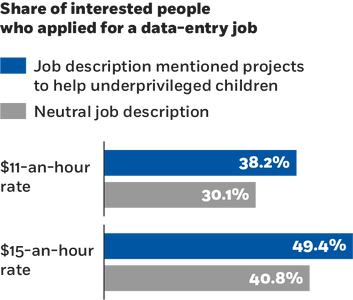 Helping schoolkids involved a social impact—and had a big effect on recruiting. When that social mission was mentioned in emails, the company saw 26 percent more people interested in the job, comparable to the 33 percent bump the company saw when it offered $15 an hour. Advertising jobs that had a social mission improved the pool of applicants, with no additional, and potentially expensive, recruiting tactics required. “This generation of young workers is more compelled than previous generations to do social good,” List says. People who accepted a job originally advertised as CSR-driven were also more effective at work. Employees in the CSR group were more productive, analyzing images in a shorter amount of time than other workers. And while all employees could work any number of hours over a 10-day period, those in the CSR group worked longer hours. Both women and men were affected by corporate responsibility, but in different ways. Women were 40 percent more productive in accurately analyzing Google Street View images as a result of CSR and worked an hour more per day. Men produced higher-quality results but did not increase the number of images that they analyzed. “Together, these insights suggest that CSR draws out higher output from women and higher quality from men,” the researchers write. “CSR should not be viewed as a necessary distraction from a profit motive, but rather as an important part of profit maximization similar to other non-pecuniary incentives.” Customers and employees, List assures, will still view CSR as authentic, even if it is recognized to boost profits. While the results suggest that CSR can have strong, positive effects, List recommends companies keep the findings on moral licensing in mind and monitor employee behavior. He notes that because so much behavior is driven subconsciously, simply making employees aware of the tendency to couple good actions with bad could counteract the bias. WORKS CITED
|
 RSS Feed
RSS Feed
